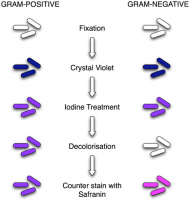








A method of differentiating bacterial species into two large groups ie)gram-positive and gram-negative known as Gram staining. The name comes from the Danish bacteriologist Hans Christian Gram, who developed the technique.
Gram staining differentiates bacteria by the chemical and physical properties of their cell walls by detecting peptidoglycan, which is present in a thick layer in gram-positive bacteria.In a Gram stain test, gram-positive bacteria retain the crystal violet dye, while a counterstain (commonly safranin or fuchsine) added after the crystal violet gives all Gram-negative bacteria a red or pink coloring.
The Gram stain is almost always the first step in the identification of a bacterial organism. While Gram staining is a valuable diagnostic tool in both clinical and research settings, not all bacteria can be definitively classified by this technique. This gives rise to gram-variable and gram-indeterminate groups as well.
History
The method is named after its inventor, the Danish scientist Hans Christian Gram (1853–1938), who developed the technique while working with Carl Friedländer in the morgue of the city hospital in Berlin in 1884. Gram devised his technique not for the purpose of distinguishing one type of bacterium from another but to make bacteria more visible in stained sections of lung tissue.He published his method in 1884, and included in his short report the observation that the typhus bacillus did not retain the stain.
Uses
Gram staining is a bacteriological laboratory technique used to differentiate bacterial species into two large groups (gram-positive and gram-negative) based on the physical properties of their cell walls. Gram staining is not used to classify archaea, formerly archaeabacteria, since these microorganisms yield widely varying responses that do not follow their phylogenetic groups.
The Gram stain is not an infallible tool for diagnosis, identification, or phylogeny, and it is of extremely limited use in environmental microbiology. It still competes with molecular techniques even in the medical microbiology lab. Some organisms are gram-variable (meaning they may stain either negative or positive); some organisms are not susceptible to either stain used by the Gram technique. In a modern environmental or molecular microbiology lab, most identification is done using genetic sequences and other molecular techniques, which are far more specific and informative than differential staining.
Gram staining has proven as effective a diagnostic tool as PCR, particularly with regards to gonorrhoea diagnosis in Kuwait. The similarity of the results of both Gram stain and PCR for diagnosis of gonorrhea was 99.4% in Kuwait.